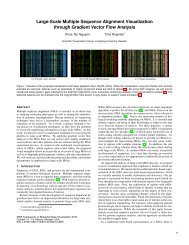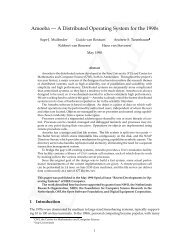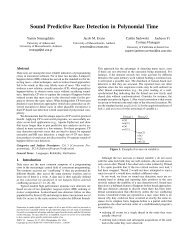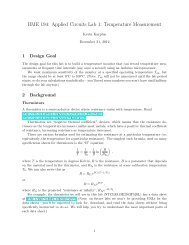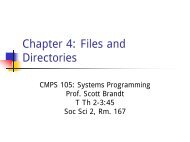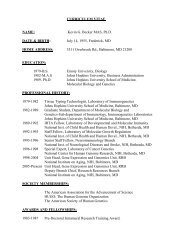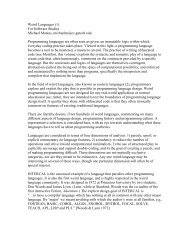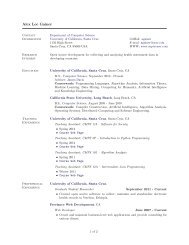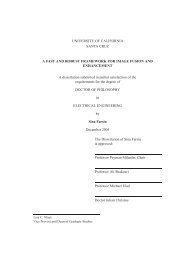Reading 1D Barcodes with Mobile Phones Using Deformable ...
Reading 1D Barcodes with Mobile Phones Using Deformable ...
Reading 1D Barcodes with Mobile Phones Using Deformable ...
You also want an ePaper? Increase the reach of your titles
YUMPU automatically turns print PDFs into web optimized ePapers that Google loves.
This article has been accepted for inclusion in a future issue of this journal. Content is final as presented, <strong>with</strong> the exception of pagination.<br />
6 IEEE TRANSACTIONS ON PATTERN ANALYSIS AND MACHINE INTELLIGENCE, VOL. 33, NO. X, XXXXXXX 2011<br />
Fig. 6. The space ðdo; dwÞ can be broken into polygons in which the<br />
conditional likelihoods pkðIjo; wÞ are constant. (a) shows this partition for<br />
symbol “2,” for which fr2 i g is f2; 1; 2; 2g. Each one of the four bars in a<br />
symbol defines a set of parallel lines in the space ðdo; dwÞ; for example,<br />
when the values of ðdo; dwÞ in (b) cross one of the red lines, the right<br />
boundary of the first bar crosses a pixel and, therefore, the likelihood<br />
changes. (c)-(d) show in red the sets of parallel lines corresponding to<br />
bars 2-4. The equations for these lines are easily computed; for the third<br />
1<br />
bar (d), for instance, we can write dw ¼ 2þ1þ2 do þ q. The final partition<br />
is shown in (a). Intuitively, if ðo1;w1Þ and ðo2;w2Þ fall <strong>with</strong>in the same cell<br />
of (a), the conditional likelihoods p2ðIjo1;w1Þ and p2ðIjo2;w2Þ are<br />
identical. In other words, instead of computing the integral in (11) over<br />
every point of the space, the problem can be made tractable by only<br />
considering one point per cell <strong>with</strong>out introducing any approximation<br />
(see Section 3.2).<br />
Hence, a variation of o or w determines a change of Ai (and<br />
therefore of pkðIjo; wÞ) only when it causes di 1 or di to cross<br />
over an integer value. Consequently, pkðIjo; wÞ is piecewise<br />
constant, and the integral in (11) can be computed exactly as<br />
a sum of a few dozen terms. Next, we show how to compute<br />
the terms in this sum.<br />
Let fV t kg be the minimum partition of the ðo; wÞ plane<br />
such that pkðIjo; wÞ is constant <strong>with</strong>in each cell V t k (<strong>with</strong> t<br />
representing the index of cells in the partition). Then,<br />
pkðIÞ / X<br />
e Dt<br />
ZZ<br />
pðo; wÞ do dw; ð14Þ<br />
t<br />
where Dt ¼ DðI;M k<br />
o;wÞ for any ðo; wÞ in Vtk . Note that the<br />
cells V t k are polygonal as they are defined by the lines of<br />
equation o þ wð Pi l¼1 rk l 1Þ ¼q, where q is any integer and<br />
i is any integer between 1 and 4 (see Fig. 6). The list of cells<br />
fV t kg, as well as the integral of pðo; wÞ <strong>with</strong>in each cell, can<br />
be computed offline and stored for online use. In fact, one<br />
easily sees that the cells form a periodic pattern (<strong>with</strong><br />
period equal to 1 both in o and w); hence only the cells<br />
<strong>with</strong>in such a period need to be stored.<br />
V t<br />
k<br />
Regarding the implementation of this procedure, the<br />
following observations are in order:<br />
1. The computation of the likelihood in (14) can be<br />
sped up by precomputing the sequences DðIðnÞ; 1Þ<br />
and DðIðnÞ; 1Þ. Then, for each cell, one only needs<br />
to add together selected samples from the two<br />
sequences. Suppose that (11) requires summing over<br />
Nj cells. For each cell V t j;k<br />
, the negative log-likelihood<br />
Dt needs to be computed, which requires two<br />
additions and two multiplications per sample, overall,<br />
2Nj additions and 2Nj multiplications per<br />
sample. However, it is easily seen that by precomputing<br />
DðIðnÞ; 1Þ and DðIðnÞ; 1Þ, each computation<br />
of Dt only requires one addition per sample. This<br />
reduces the computational weight to 2 þ Nj<br />
tions and four multiplications per sample.<br />
addi-<br />
2. At runtime, a specific set of cells is chosen from the<br />
list based on the tolerance o and w on the<br />
estimated values of o and w, which are easily<br />
derived from the tolerance of the estimated end<br />
points oL and oR. More precisely, we compute the<br />
sum in (14) over the cells that intersect the rectangle<br />
<strong>with</strong> sides ½o o; o þ oŠ and ½w w; w þ wŠ,<br />
3.<br />
where o and w are estimated as by (5).<br />
The integration of pðo; wÞ <strong>with</strong>in each cell result is<br />
particularly simple if pðo; wÞ is assumed to be<br />
uniform <strong>with</strong>in the considered rectangle in the<br />
ðo; wÞ space. In this case, the integral is proportional<br />
to the area of the polygonal cell, which can be easily<br />
computed and stored offline. In our implementation,<br />
we made use of this simple, yet effective model.<br />
As will be shown shortly, it is also useful to estimate, for<br />
each possible symbol k, the deformation parameters ðo; wÞ<br />
given the intensity profile IðnÞ <strong>with</strong>in a digit segment. We<br />
choose the least squares estimator ðok; wkÞ of these quantities<br />
(under the density pðo; wÞ), which is given by the conditional<br />
expectation. <strong>Using</strong> Bayes rule, this is equivalent to<br />
ZZ<br />
ðok; wkÞ<br />
¼ ðo; wÞ pkðIjo; wÞpðo; wÞ<br />
do dw<br />
pkðIÞ<br />
/ 1<br />
pkðIÞ<br />
X<br />
t<br />
e Dt<br />
ZZ<br />
V t<br />
k<br />
owpðo; wÞ do dw:<br />
ð15Þ<br />
The integrals in the above equation can be precomputed<br />
and stored for online use. If the assumption of uniformly<br />
distributed ðo; wÞ is made (as in point 3 above), then the<br />
terms in the sum are the centroids of the cells fV t k g.<br />
Imposing Spatial Coherence. Our model makes the simplifying<br />
initial assumption that the digit segments are equally<br />
spaced (see (5)-(6)). This also implies that the base width w<br />
is constant across the barcode. In practice, we should expect<br />
that the digit segment length may vary from segment to<br />
segment, generally <strong>with</strong>in the confidence intervals o and<br />
w. Ideally, however, the segment representing a given<br />
digit in the scanline (as computed from the estimates ok and<br />
wk) should be adjacent to (but nonoverlapping <strong>with</strong>) the<br />
neighboring segments. The choice of an incorrect value of k<br />
due to single-digit analysis is likely to result in a supported<br />
segment that does not fit together well <strong>with</strong> the other<br />
segments (see Fig. 7). This observation can be exploited by<br />
imposing a global constraint as follows:




